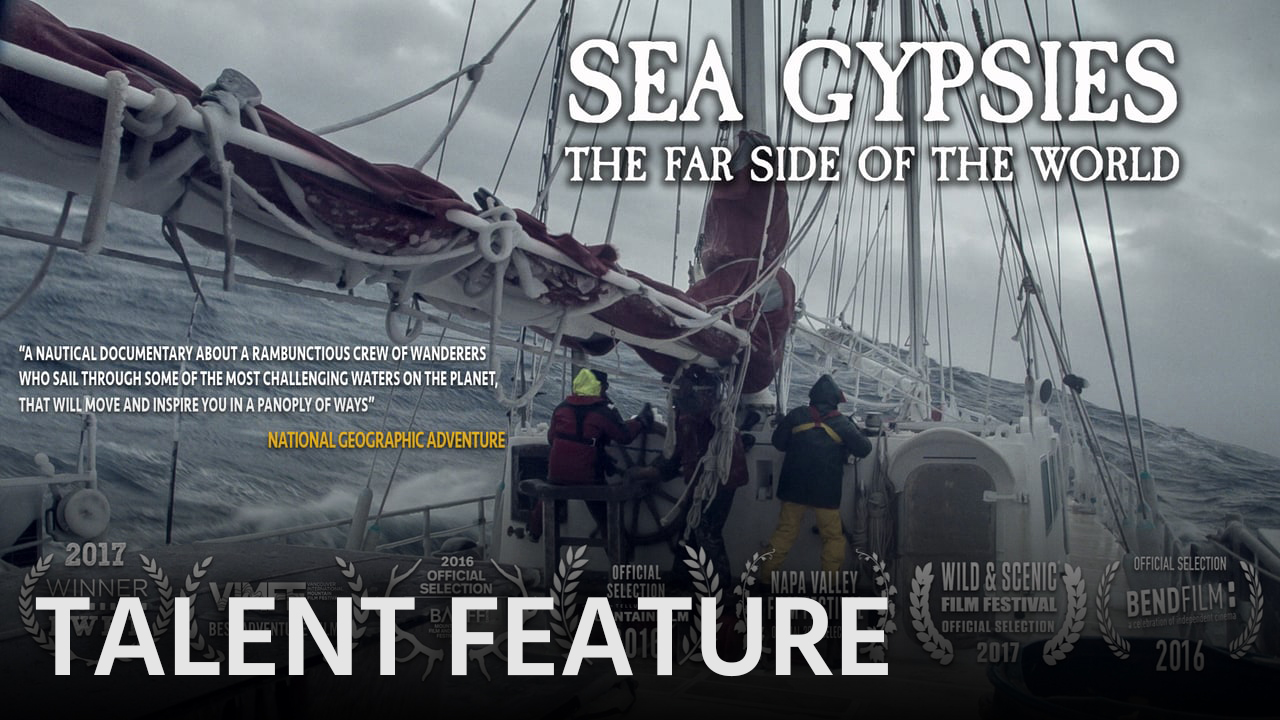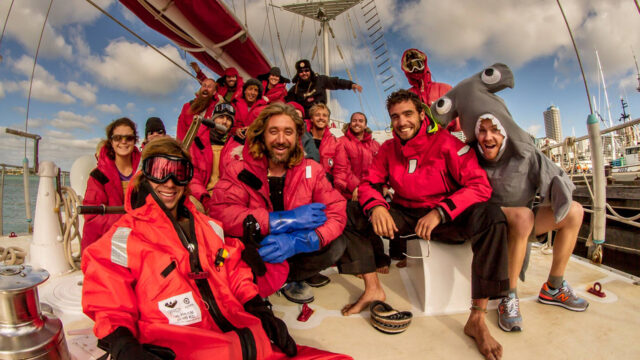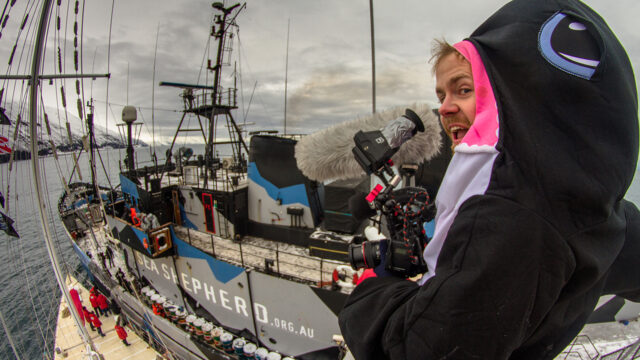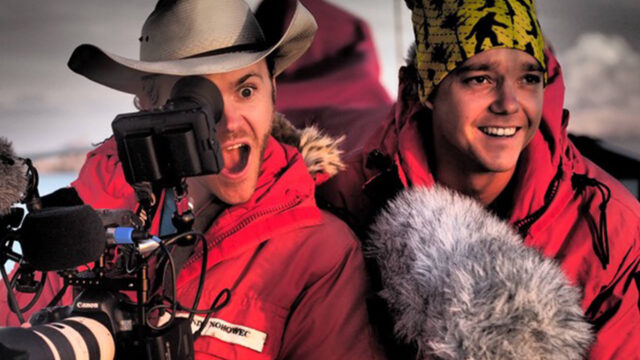
My name is Nico Edwards, and I’m a blog-taught filmmaker seeking to tell compelling character-driven stories of people living creative and alternative lifestyles. Sea Gypsies – The Far Side of the World is my first feature length film, premiering at Telluride Mountain film Festival. After its international premiere at Banff Mountain Film Festival, it was chosen to tour the world in over 40 countries with the Banff on Tour and Ocean Film Festival on Tour along with about 30 other film festivals so far, where it has won a handful number of awards.
Name and age: Nico Edwards, 34 years old.
Currently based in: Tonga. But the sailboat I live on is heading north, so never in one spot for too long.
Language (s) spoken: English.
Occupation: Full-time filmmaker, part-time editor and, until rather recently, worked in a cubicle at a battery company
How did you get started in our industry? A couple of years ago, I had just about the most boring job imaginable: buying bulk chemicals for a battery company. My job (like so many office jobs) did allow me a whole lot of free time though – a rather obscene amount as long as I looked busy and didn’t wander too far from the cube. So, I devoted that time to watching YouTube tutorials and reading video blogs such as cinema5D, NoFilmSchool and Newshooter. The aim was to improve on my hobby of editing together my little vacation videos. Eventually, I got together some better equipment (Canon Rebel T2i), a couple of cheap but decent lenses (Canon 50mm f/1.8, Canon 24-105 f/4 IS, Tokina 11-16mm f/2.8) and a used Glidecam 2000 from Ebay, and started making videos on the weekends for small businesses – either for free or cost – just for the experience. After a few of those, I felt like I was ready to quit my job, find some adventure or story and make a feature length documentary film… I really like documentaries, and figured: how hard could it possibly be? I’m so thankful I had absolutely no idea what I was getting myself into, or I would never have started.
Current assignments: I just wrapped up a year of film festivals for Sea Gypsies, and was able to secure distribution as well as a bit of financing for the next one, and so I’m lucky enough to be starting production on the sequel in two weeks.
What is your dream assignment / job in our industry, and what are you really passionate about? I really like making documentaries about the ocean. It’s a specific niche, but I love the freedom one can only really get in the unownable ocean and think that compelling characters are attracted to a life at sea. I would like to keep documenting the various stories that are out there just floating around for free.
I also think that it’s one of the few ways to make a visually appealing, highly entertaining film that requires no connections and does not cost a lot. You don’t need permits, there are few if any laws out in the ocean to worry about, there is dramatic scenery, no rent, no distractions and plenty of time to get your cast comfortable with being on camera all the time. Sea Gypsies was made for less than 1/20th of the cost of the other documentary features it screens with at festivals. In fact, the whole film broke even financially just from the screening fees earned at film festivals.
That said, it would be nice to have a bigger budget and a bit more help in the future. I did Sea Gypsies myself because that’s really the only way it was going to get made, and it was a fantastic experience wearing all the hats: director, writer, DP, narrator, producer, editor, etc. But having a life would be nice too, and collaboration brings about better efficiency and makes stories far more dynamic.
In the work that you are presenting us, now that it is done, what would you have done differently throughout the production? Making Sea Gypsies the way I did, everything was geared towards top image quality throughout the entire process, and if I were to do it again, I would cut back on that for editing. I would have edited with low-res proxy files for one starters, as I wasted resources on cramming an obscene amount of RAM and a top-of-the-line GPU into a massive gaming laptop so that I would be able to edit 10-bit HD files at full resolution with total mobility. It’s nice to see exactly how it’s going to look as you edit, but it wasted time and resources. I would have also gotten a custom-made music score. Editing the film to found music created the nightmare of then having to get those licenses, and though I really lucked out with so many great bands getting interested in the project, it took a whole lot of time. One track I really did not want to part with took 15 months to get the license – I had to wear them down like water on granite. But if you shed all pride and get very comfortable with constant rejection, you can accomplish a lot.
You chose to shoot your project with the Canon 5D Mark III. Can you please describe why you chose to use it, what was your workflow, were you happy with the results and will you ever go that way again? I shot Sea Gypsies on a Canon 5D Mark III – video, time lapses and stills, in temperatures ranging from 40+ Celsius in the tropical jungles to easily -20 Celsius in a hurricane of frozen saltwater in Antarctica. It went everywhere with me, from scuba diving 170 ft (51 meters) underwater in an Odyssee housing, to taking time lapses all night at the top of a volcano, to being jolted around on a Glidecam smashing through waves on a chase boat, all on the same single camera. I can’t think of another camera that could be so versatile. After a year of that, the corrosion was so bad the screws were all falling out on their own, but it still works fine!
My workflow for Sea Gypsies is scary to think back on, though. Coincidently, I got the idea to go make a film just at the time that some wonderful geniuses figured out how to hack into the Canon 5D Mark III to output full beautiful RAW video. They called their wonderful free product Magic Lantern RAW. I had never seen such beauty in such an affordable package: 14 stops of dynamic range in full HD, with that buttery Canon still-image look. So I got a 5D3, disregarded all those “it might turn your camera into a paperweight” warnings, and started tinkering around with the first nightly builds for the RAW module. It was a total nightmare of a workflow, but a supremely gorgeous nightmare. I think it really helped that I had no real idea what I was doing, or training in a superior workflow with which to compare it to. All I knew was that I was getting a stunning image I could easily grade myself in Adobe Lightroom for a tiny fraction of the cost of a professional setup. I also had way more time than money, so spending hours with a hacked workflow was more doable than magically coming up with the $40,000+ it would have taken at the time to get a video camera that shot RAW. The only camera I can think might have been comparable was the C500 with an external recorder, but it would never have been able to go everywhere like the 5D did.
Here was my workflow for Sea Gypsies – much if it taken from the cinema5D guide on shooting RAW on the 5D3.
- 5D3 and Magic Lantern module pumps thousands of strange unreadable picture files to CF card, which I then transcoded to DNG images in another free enthusiast-created program (raw2dng).
- Grade the first image in Adobe Lightroom, and apply the look to entire sequence. Then import the entire sequence to After Effects and export as DNX 422 after having fully taken advantage of the extremely wide dynamic range of 14 stops or so. I couldn’t do ProRes due to only having a PC, which way cheaper and more powerful. It would take roughly 9 hours to render a day’s worth of shooting (30 minutes of footage) so I had it work while I slept.
- I was able to edit this off of five 4TB Touro 7200 rpm drives ($140 each at B&H) that I connected via a USB 3.0 hub.
Stitching together thousands of photos into video in After Effects didn’t really bother me. What was really annoying was having to record all audio on an external recorder and manually syncing it to the camera’s beep as it started recording the first frame, or by looking at lips if I could not hear the beep. Just had to remember to start recording the audio first, before I hit record on the camera. Also, a 64GB CF card only lasted 10 minutes, often got too hot and stopped, or became corrupted with the dreaded pink frames. All told, I created about 200 hours (20TB) of video that took months to manually sync to the audio I recorded separately.
The lenses I used for Sea Gypsies were the Canon 24-105 f/4 IS, Canon 50mm f/1.4, Canon 70-200 f/2.8, Canon 100mm Macro f/2.8, Canon 16-35 f/2.8. Audio was recorded with a Rode NTG3 going to a Zoom H6N that I had bolted to the Wooden Camera cage on the 5D3. I also had to have heaps of ND filters and polarizers to make the setup work.
After the shooting was all done, I sold most of my gear, rented a really really really cheap hotel room in Bangkok and edited Sea Gypsies around the clock, 7 days a week. I had all meals delivered to me and rarely left the room for fear of my laptop being stolen. I applied to grants so I could get some money for music licensing and final audio mixing. Thankfully, the footage turned out great and I was able to get a commitment grant from Telluride Mountainfilm that made finishing the film possible.
Interestingly, I was able to track the views of the rough copy on Vimeo and found that most places I applied to for grants never even watched the film. Other than Telluride Mountainfilm, they mostly all charge fees to apply, which was disheartening. I won’t waste my time or money on those scams ever again.
What current camera, lenses and sound equipment do you use? I’m hooked on the post flexibility of RAW and need the dynamic range as the ocean is a super high-contrast environment. Although I’ve never gotten any deals from them (not for lack of trying), I’m pretty much a Canon loyal and, thanks to the success of the first film, I have been able to afford the new Canon C200. This time though, I will be editing with the 8-bit mp4 proxies for the most part, considering Premiere is not yet able to read the 12-bit Canon Raw Lite files. I will be taking back some of the same glass though, with a few additions, now that I can utilize lenses for smaller Super 35 sensors. Canon 24-105mm f/4 IS, Canon 50mm f/1.4, Canon 70-200mm f/2.8 IS, Canon 17-55mm f/2.8 IS, Canon 10-18mm f/4.5 IS, Rokinon 8mm f/3.5, and a very interesting ultra wide Venus Optics 15mm macro lens. For audio, I will record internally to camera from my trusty Rode NTG 3 (which is a solid beast) and the Rode blimp with dead wombat, which is a must for windy conditions. I will also be taking my trusty 5D3 for stills and time lapses, and maybe a little Magic Lantern. That camera just won’t die – Canon seems to have forgotten to engineer in the planned obsolescence.
What’s your favorite light equipment and why did you choose that kit over other solutions? I used a small $40 LED panel from Ebay/China (Amaran AL-M9). I specifically put shooting RAW at the top of my priority list so I could be a one-man band, and not have to worry as much about lighting and time-consuming setup of lights and diffusers. The RAW is so good I was even able have different color light sources in interviews, needing only to use a gradient white balance filter in Adobe Lightroom when colouring the interviews for Sea Gypsies in post. When you are doing so much yourself, it’s fantastic to have so much ability to fix almost anything in post.
Do you use drones or gimbals in your productions? I use a $250 Glidecam. It’s simple, can take a direct wave hit with no electronics to break or malfunction, and handles really heavy jolting in a way that would give a Movi a stroke. When shooting in really remote conditions for so long, I’ve found it’s really best to avoid a reliance on too many technical bits and bobs. I am also looking into the SwellPro waterproof drone ($1,600), but haven’t committed yet.
What editing systems do you use? Premier Pro CC, After Effects, LR Timelapse, Adobe Lightroom.
How much of your work do you shoot in Log and what is your preferred way of colour correcting? I shoot mostly all Raw, but now I’m using Log 3 with the Canon Raw Lite.
How frequently do you travel, and do you have any tips when it comes to packing your gear? Getting loads of heavy equipment to really remote places is getting increasingly difficult and expensive. I put my tripod and all the less valuable stuff in my 2 checked pelican cases, and fully expect some of their contents to not make it to the final destination. I pack everything I really can’t have stolen – such as camera, media, laptop, hard drives and lenses – in my carry-on backpack. The largest one i’ve found that is technically carry-on legal is the large Tenba Shootout backpack, and it can easily weigh over 60lbs (27kg) when full, which is a problem. I try and have it slung over just one shoulder opposite the gate attendant side when boarding so they can’t see the full size, which also gives the false impression that it’s lighter. But they are getting wise, and a lot of airlines have taken to weighing my carry-on bag when they see me struggling up to the gate with its heft digging into my shoulders. So, the best tip I have learned is to take along a big trench coat with loads of deep pockets, and stuff them with all the really heavy stuff like batteries, metal tools, moveable metal locking arms, lenses, etc. They aren’t weighting people yet in most places, so you can easily get 30lbs (14 kilos) stuffed in a coat. Once in the plane you can just put the stuff back in the case and tuck the coat away. I also sling my camera(s) over my shoulder when I board, behind the coat.
Also it’s a good idea to get a credit card that gives you free checked bags and priority boarding. When your carry-on bag is so heavy the stitching feels like it could fail at any moment, you really want to get on the plane first, so you have a place to stash it out of the way, or they might try and force you to gate-check it. The United Club card, for example, gives you priority boarding and also gives you two free checked bags for domestic and three for international flights. It basically pays for itself in two trips, and I think they treat your luggage better. Spending all the money required to get the bonus miles for these cards can be a chore, but just Google “manufactured spending” for tips and tricks.
If you want to know more about Nico Edwards and Sea Gypsies, head over to seagypsiesmovie.com.



























